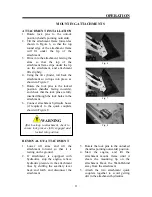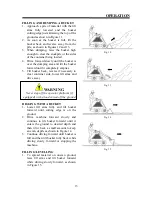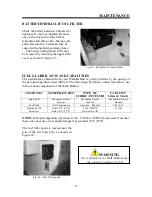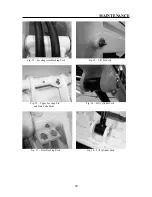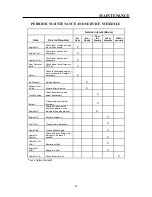
6
CONTROL
left hand should hold onto the grip
handle for stability, but can also be used
to operate the tilt and dump functions as
required.
NOTE
: Be sure to slowly move the
levers to the center (neutral) position
when stopping. The Walk-Behind will
stop INSTANTLY if the operator
releases the drive levers.
Warning
Do not move any of the control levers
unless standing with both feet on the
platform (if equipped) and holding the
grip handles
Warning
When reversing the machine,
particularly when executing a turn while
reversing, be aware of where your feet
are in relation to the tracks at all times
to prevent backing over your toes
Warning
Use extreme caution when stopping. If
the bucket or attachments are raised
when stopping, the machine can tip.
Keep all movements smooth. All new
operators must work the machine in a
safe open area to become familiar with
its operating characteristics.
LIFT CONTROL LEVER – Item 3,
Fig. 2
The outside control lever located on the
left-hand side controls the lift. Pushing
the lever forward lowers the lift arm and
pulling the lever back raises the lift arm.
The lever is spring-centered to return to
neutral upon release.
TILT CONTROL LEVER – Item 4,
Fig. 2
The inside control lever located on the
left-hand side controls the tilting action
of attachments such as buckets, forks,
etc. Pulling the lever back rolls the
attachments back. Pushing forward on
the lever tilts forward or “dumps” the
attachment. The lever is spring-centered
to return to neutral upon release.
FLOW DIVIDER – Item 1, Fig. 2
The walk-behind features a variable flow
divider which splits available oil flow
between the auxiliary circuit and the
loader functions. This allows selection of
the relative speeds of the machine and
attachments, and enables the operator to
set the machine speed and attachment
flow to match the conditions of any
given job.
For applications such as trenching
and tilling almost all flow should be
diverted to the attachment, leaving only
enough flow to the wheel motors for
crawling the machine along. Other
attachments such as grapple buckets will
require a more balanced flow.
Even when the auxiliary circuit is not
in use, the flow control can be used to
vary machine speed. For work in close
quarters, and while learning to drive, set
the flow to the machine to low. If, on
the other hand, you need to travel longer
distances quickly, set the flow divider to
high machine flow in order to achieve
higher ground speeds.
Be aware that the flow control will
also change the speed of various
machine functions such as lift and tilt.
With full flow to the machine, these
functions will operate quickly.




















